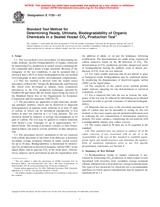Potrebujeme váš súhlas na využitie jednotlivých dát, aby sa vám okrem iného mohli ukazovať informácie týkajúce sa vašich záujmov. Súhlas udelíte kliknutím na tlačidlo „OK“.
ASTM E1720-01
Standard Test Method for Determining Ready, Ultimate, Biodegradability of Organic Chemicals in a Sealed Vessel CO2 Production Test
Automaticky preložený názov:
Štandardná skúšobná metóda pre stanovenie Ready , Ultimate , biologickej rozložiteľnosti organických chemikálií v produkčnom teste Uzatvorené CO2 Vessel
NORMA vydaná dňa 10.10.2001
Informácie o norme:
Označenie normy: ASTM E1720-01
Poznámka: NEPLATNÁ
Dátum vydania normy: 10.10.2001
Kód tovaru: NS-42775
Počet strán: 6
Približná hmotnosť: 18 g (0.04 libier)
Krajina: Americká technická norma
Kategória: Technické normy ASTM
Anotácia textu normy ASTM E1720-01 :
Keywords:
ICS Number Code 13.080.30 (Biological properties of soil)
Doplňujúce informácie
| Significance and Use |
|
As a ready biodegradability test, when using non-adapted inoculum, the sealed vessel method provides only a limited opportunity for biodegradation and acclimatization to occur. It may therefore be assumed that a chemical yielding a positive result in this stringent test will biodegrade rapidly and ultimately in the environment. Generally, no further biodegradability testing would be required for a chemical that passes this test unequivocally. The sealed vessel test is applicable to the testing of volatile test chemicals because the biodegradative formation of CO2 occurs in a closed system. The sealed vessel test is also appropriate for testing sparingly soluble chemicals and for chemicals that bind to inoculum, since biodegradability is based on the analysis of a soluble formation product rather than on the disappearance of the sparingly soluble substrate. Ample replicate sampling for rate determination or statistical evaluation, or both, is feasible because of the speed, economy, and space efficiency of the sealed vessel test. The sealed vessel test is ideal for the comparative testing of groups of chemicals and for generating structure-activity data bases also because of its speed, economy, and space efficiency. |
| 1. Scope |
|
1.1 This test method covers procedures for determining the ready, ultimate, aerobic biodegradability of organic chemicals by monitoring CO2 production in sealed vessels containing the test compound and a dilute sewage inoculum. Because of the stringency of the test conditions, it can be assumed that a chemical that is 60% or better biodegraded in this test method will biodegrade in most aerobic environmental compartments. 1.2 This test method is derived from the sealed vessel procedures of Birch (1), Struijs (2), Boatman (3), and Peterson (4), which were developed as simpler, more economical alternatives to the CO2 production techniques reported by Gledhill (5) and Sturm (6), the Sturm report being the basis of the Modified Sturm Test of the Organization for Economic Cooperation and Development (OECD) (7). 1.3 The procedures are applicable to pure materials, including sparingly solubles, which can be dissolved or dispersed homogeneously in aqueous stock solutions of at least 25 ppm of carbon, or which can be introduced reproducibly to test bottles as pure test material in 1 to 2-mg portions. The test chemical should be nontoxic to sewage microorganisms at 10 ppm of carbon. The test may be applied to volatile materials with Henry's Law Constants of up to approximately 10 -2 atm/m3 /mole. The testing of mixtures, extracts, or fully formulated products can lead to serious problems in data interpretation. 1.4 The procedures involve incubation of the test chemical with a dilute inoculum of microbes from domestic wastewater secondary sewage treatment effluent in small, sealed vessels for up to 28 days. Biodegradability is determined by monitoring CO2 production as dissolved inorganic carbon (DIC) in the liquid phase, and as gaseous CO2 in the head space. Alternatively, analysis can be performed on just the liquid phase after the addition of alkali, or on just the headspace following acidification. The determinations are made using commercial carbon analyzers based on the IR detection of CO2 . The determination of CO2 production provides unequivocal proof of biodegradation, barring the unlikely event of abiotic production of CO2 from the test material. 1.5 For water-soluble materials that do not adsorb to glass or biological solids, biodegradation may be confirmed further by monitoring the disappearance of dissolved organic carbon (DOC) in the liquid phase. 1.6 The simplicity of the sealed vessel method permits ample replicate sampling for rate determination or statistical evaluation, or both. 1.7 For a chemical that fails the test as written, the stringency of the test may be reduced by substituting an acclimated inoculum in order to provide a measure of inherent biodegradability. 1.8 Materials that are toxic to the microbial inoculum at 10 ppm of carbon may not be amenable to testing by this test method, or they may require special method modification such as reducing the test concentration if instrumental sensitivity permits. For some cationics, complexing the test material with a nondegradable anionic may reduce toxicity. 1.9 The values stated in SI units are to be regarded as the standard. 1.10 This standard does not purport to address all of the safety concerns, if any, associated with its use. It is the responsibility of the user of this standard to establish appropriate safety and health practices and determine the applicability of regulatory limitations prior to use. For specific precautionary statements, see Section 6. |
Odporúčame:
Aktualizácia zákonov
Chcete mať istotu o platnosti využívaných predpisov?
Ponúkame Vám riešenie, aby ste mohli používať stále platné (aktuálne) legislatívne predpisy
Chcete vedieť viac informácií ? Pozrite sa na túto stránku.




 Cookies
Cookies
